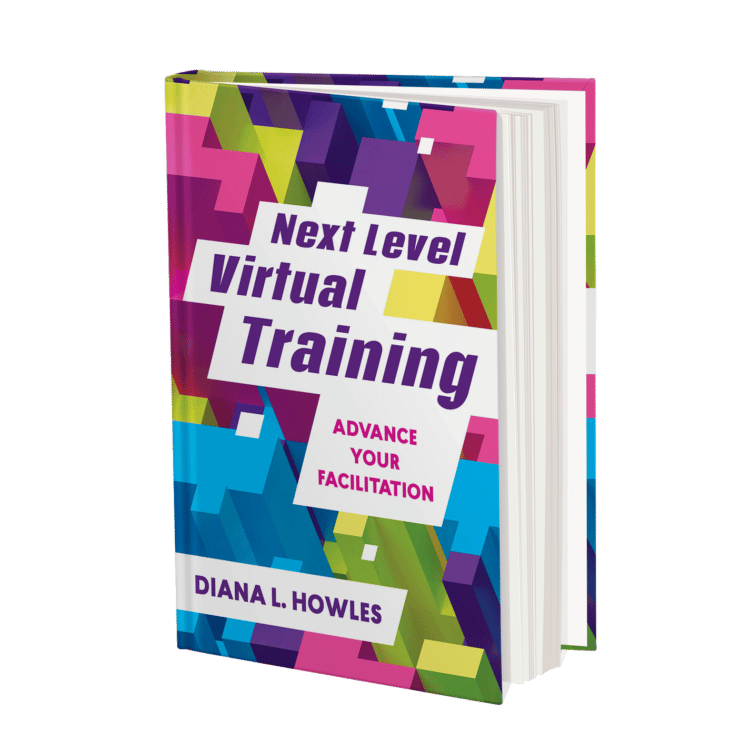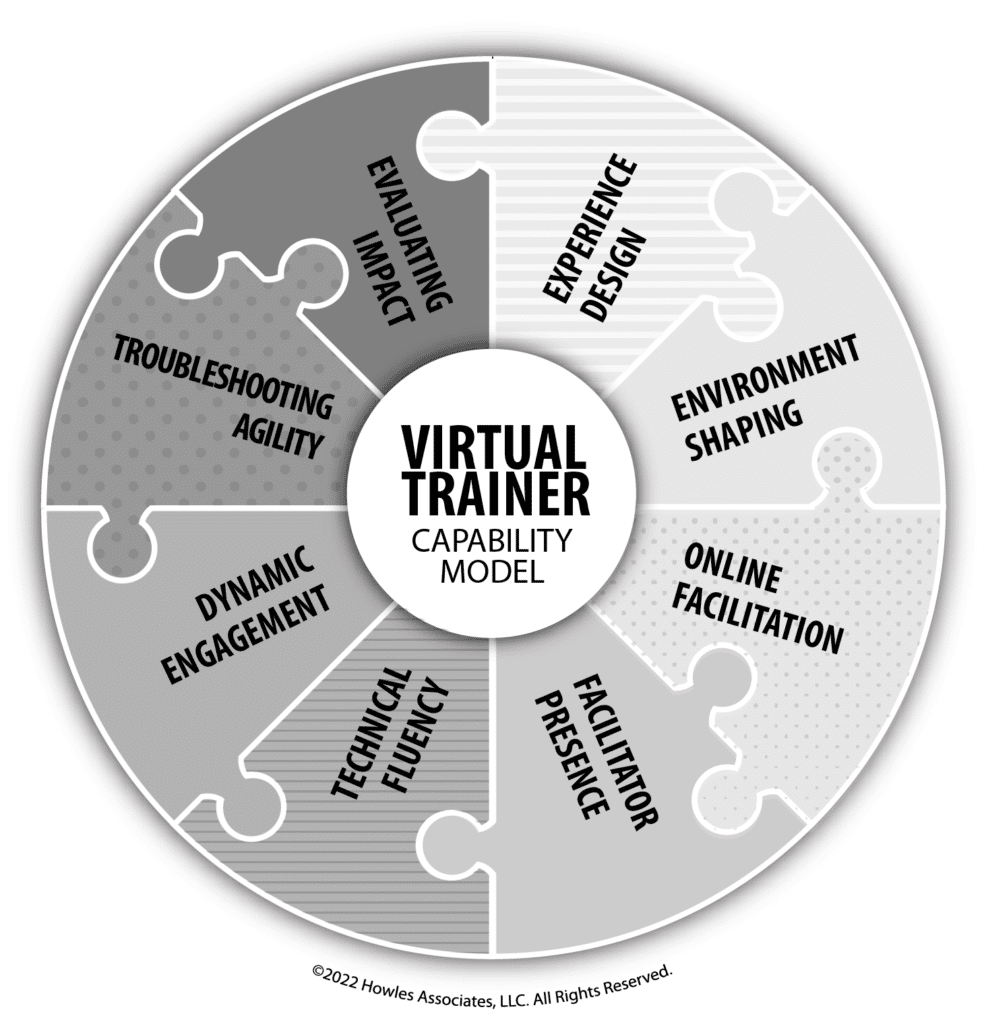
Diana Howles is an award-winning speaker, global virtual facilitator, and master trainer with 25 years of experience in the talent development field. Diana is CEO and co-owner of Howles Associates and author of Next Level Virtual Training: Advance Your Facilitation.
In this episode of the Leading Learning Podcast, co-host Celisa Steele talks with Diana about Next Level Virtual Training, the capability model she developed for virtual facilitators, and the pros and cons of hybrid or, as she prefers to call it, “live mixed” learning. Diana also shares practical tips and strategies for anyone looking to improve their virtual facilitation.
To tune in, listen below. To make sure you catch all future episodes, be sure to subscribe via RSS, Apple Podcasts, Spotify, Stitcher Radio, iHeartRadio, PodBean, or any podcatcher service you may use (e.g., Overcast). And, if you like the podcast, be sure to give it a tweet.
Listen to the Show
Access the Transcript
Download a PDF transcript of this episode’s audio.
Read the Show Notes
[00:00] – Intro
Next Level Virtual Training: Advance Your Facilitation
[01:49] – Would you tell us about the origins of Next Level Virtual Training: Advance Your Facilitation, which came out in 2022?
The pandemic threw the whole world into virtual training, and Diana had lots of experience working in virtual training. She wanted to share her experience and help equip facilitators for the new more virtual world.
Diana noticed a lack of professional development offerings for virtual facilitators. For example, there wasn’t a dedicated resource on hybrid learning that engages on-site and online learners together. So Diana thought it would be a great time to write a book to help people be more effective online.
Jon Aleckson of Web Courseworks has written a blog post on Next Level Virtual Training. The post is part review and part reflection on the application of key concepts and serves as a good introduction to key topics Diana covers in her book.
Virtual Training Capability Model
[03:16] – What’s the difference between a competency model and a capability model? How did you arrive at the eight areas of expertise covered by the capability model that’s at the core of Next Level Virtual Training?
Diana looks at competence as the destination and capability as the journey. The goal is to be fully competent, but capabilities speak to our growth as we try to reach that ultimate destination. Capabilities are a blend of knowledge and skills, which grow over time.
Diana wanted to focus on capabilities and helping people with knowledge and skills in key areas. The capability model for virtual facilitators has eight core areas of expertise. It took a lot of iteration to narrow the model down to these eight.
The State of Online Learning
[06:27] –Because of the pandemic, the majority of people have experienced live online learning. What’s your assessment of where we are in terms of not just delivering live online learning opportunities but in designing and facilitating them to be effective?
We’re at a place where everyone has been introduced to these platforms or had experience using them, but we haven’t yet reached the point of effective design. This is why Diana wanted to create the book Next Level Virtual Training.
We’re challenging people not just to use the platform but to do it in a very thoughtful way that’s designing for being able to have outcomes and change the way people, after the learning, change the way they perform at work or even in their fields of work.
Diana Howles
There are many things we can do to leverage more the tools. It’s more than just going through the motions; it’s about being more thoughtful.
Effectiveness of Single-Session Learning
[08:34] – When you think about designing live synchronous learning, you think about ways to prepare learners for the live sessions and/or to follow up with them after. Do you believe that single-session learning can be effective, or do you always look to add pre- or post-content to live online sessions?
Diana has seen single sessions be effective. But the research is clear that, when we have blended learning solutions, we have much better retention and application. She always tries to include some prep work because learners then tend to come to class better prepared to have a good discussion.
Post-work offers the possibility for spaced repetition over time and reinforces learning. Diana sometimes uses a one-by-one-by-one approach. She has learners do something one day after a session, one week after, and then one month after. Spreading out the learning and using the live synchronous class as part of a larger solution creates more effective learning long term.
Partner with Tagoras

[10:48] – At Tagoras, we’re experts in the global business of lifelong learning, and we use our expertise to help clients better understand their markets, connect with new customers, make the right investment decisions, and grow their learning businesses.
We achieve these goals through expert market assessment, strategy formulation, and platform selection services. If you are looking for a partner to help your learning business achieve greater reach, revenue, and impact, learn more at tagoras.com/services.
Pros and Cons of Hybrid Learning
[11:18] – What are the pros and cons of hybrid approaches to learning, where some learners engage in person and others engage online at the same time?
Diana likes prefers the term “live mixed” because she feels the term to “hybrid learning” has been overused and is used in non-learning contexts (e.g., hybrid cars). You have a mix of on-site and online learners together, and it’s live (i.e., happening in real-time), so she calls it “live mixed.”
There are inherent challenges because you have double the technology. The facilitator is taxed with many things to manage at once, which places a high cognitive load on them. There are ways that we can have effective live mixed learning, but it requires strategies, like those that follow.
- Partner with a co-facilitator. One is the lead. The lead can be either the virtual or the on-site facilitator, but, either way, you have a facilitator in each space. This helps the learners as well as lightening the load for the facilitators.
- Have IT support available. If something goes wrong, you want it to be remedied right away. Sometimes IT can just be there for the opening piece.
- Give learners choice. This leverages learner agency and autonomy and also adds to their investment in the learning.
- Make sure the learners are committed to how they will participate. They can choose to participate online or in-person, but they have to commit to which upfront and honor that choice to allow the facilitators to plan appropriately.
- Keep instructional practices equitable. For example, when doing a debrief, alternate between calling on someone participating virtually and someone else participating in person.
The Use of Video Cameras During Live Online Sessions
[16:13] – What guidance do you have on when and why to use video cameras during live online sessions?
Diana recommends using video cameras for purposeful connection moments. There are many benefits of using a Web cam, though the research shows that Web cams being on or off doesn’t make a difference in learning outcomes. A Stanford study done in 2015 found that learners felt an increased sense of social presence, as well as an improved experience, when Web cams were used.
Though the use of cameras doesn’t improve learning outcomes, it does make a difference in the learner experience and their perception of the facilitator’s presence, and those are valuable benefits.
Florida State University did a Web cam study in 2021 and found that there was an increased sense of closeness and that people listened better when cameras were on.
But we don’t need the cameras on all the time. Instead, we should use them for purposeful connection moments, such as during an introduction, a closing, a role-play, or a teach-back. When facilitating a large-group discussion, Diana usually stops showing other visuals and asks everybody to come on camera (she encourages them to be camera-ready before the event).
To avoid cognitive overload, if she’s showing a complex diagram, she’ll turn off her Web cam, as she wants learners to direct their focus to the diagram. If the facilitator or other learners are on camera, those are competing visuals that create extraneous cognitive load, which we want to reduce if possible.
Diana tells people that she’s going off camera to allow them to better focus on the complicated diagram. It’s about being thoughtful in how we instruct and learn and then leveraging the camera when it’s most optimal.
Tips for Improving Virtual Facilitation
[20:00] – What other advice you would offer listeners looking to improve their virtual facilitation?
We can go through the motions and facilitate on a platform virtually with remote learners. But I always try to challenge and push people to be more excellent, and how can we do that?
Diana Howles
Diana offers are two specific strategies.
- Make the invisible audible. Make the invisible audible by talking about your task. For example, if in person and a facilitator is getting their slides ready and needs to switch to a different monitor, they don’t need to make any commentary about what they’re doing because learners can see in person what is happening in the room. But when facilitating virtually you need to explain what you’re doing to avoid confusion after long pauses, for example.
- Use announced silence. Offer learners quiet time to process and reflect, and call their attention to why you, as the facilitator, are being quiet. When there are long pauses in a virtual facilitation environment, learners can wonder if there’s something wrong with the tech. Announcing silence lets learners know you’re going to be quiet and why you’re being quiet.
Approach to Lifelong Learning
[23:19] – How do you approach your own lifelong learning? Do you have specific habits, practices, or sources that you like to use in order to continue to grow professionally and personally?
Diana finds conferences to be a great source of inspiration and chance to see what’s happening in the field and where we’re headed in the future. Conferences are great places to be challenged, and pushed beyond our comfort zones.
Diana also has favorite books and resources to help her continue to improve.
She believes it’s helpful to understand the learner’s perspective because that can inform what we do as educators and facilitators. When she was doing a lot of public speaking, Diana used to sit in the back row of the auditorium or ballroom before the event to try to envision the perspective of the audience. Diana feels the same about virtual facilitation and attends virtual classes as a learner to help her be a better virtual facilitator.
So you really walk in the shoes of the learner, and you’ll observe all sorts of things that then help you be more effective when you yourself are facilitating them.
Diana Howles
[25:58] – Wrap-up
Diana Howles is CEO of Howles Associates and author of Next Level Virtual Training: Advance Your Facilitation. You can connect with Diana on LinkedIn and Twitter.
To make sure you don’t miss new episodes, we encourage you to subscribe via RSS, Apple Podcasts, Spotify, Stitcher Radio, iHeartRadio, PodBean, or any podcatcher service you may use (e.g., Overcast). Subscribing also gives us some data on the impact of this particular part of our content strategy.
We’d also be grateful if you would take a minute to rate us on Apple Podcasts at https://www.leadinglearning.com/apple or wherever you listen. We personally appreciate reviews and ratings, and they help us show up when people search for content on leading a learning business.
Finally, consider following us and sharing the good word about Leading Learning. You can find us on Twitter, Facebook, and LinkedIn.
Episodes on Related Topics:



 A GPS for Learning with Dr. Prasad Ram
A GPS for Learning with Dr. Prasad Ram
Leave a Reply